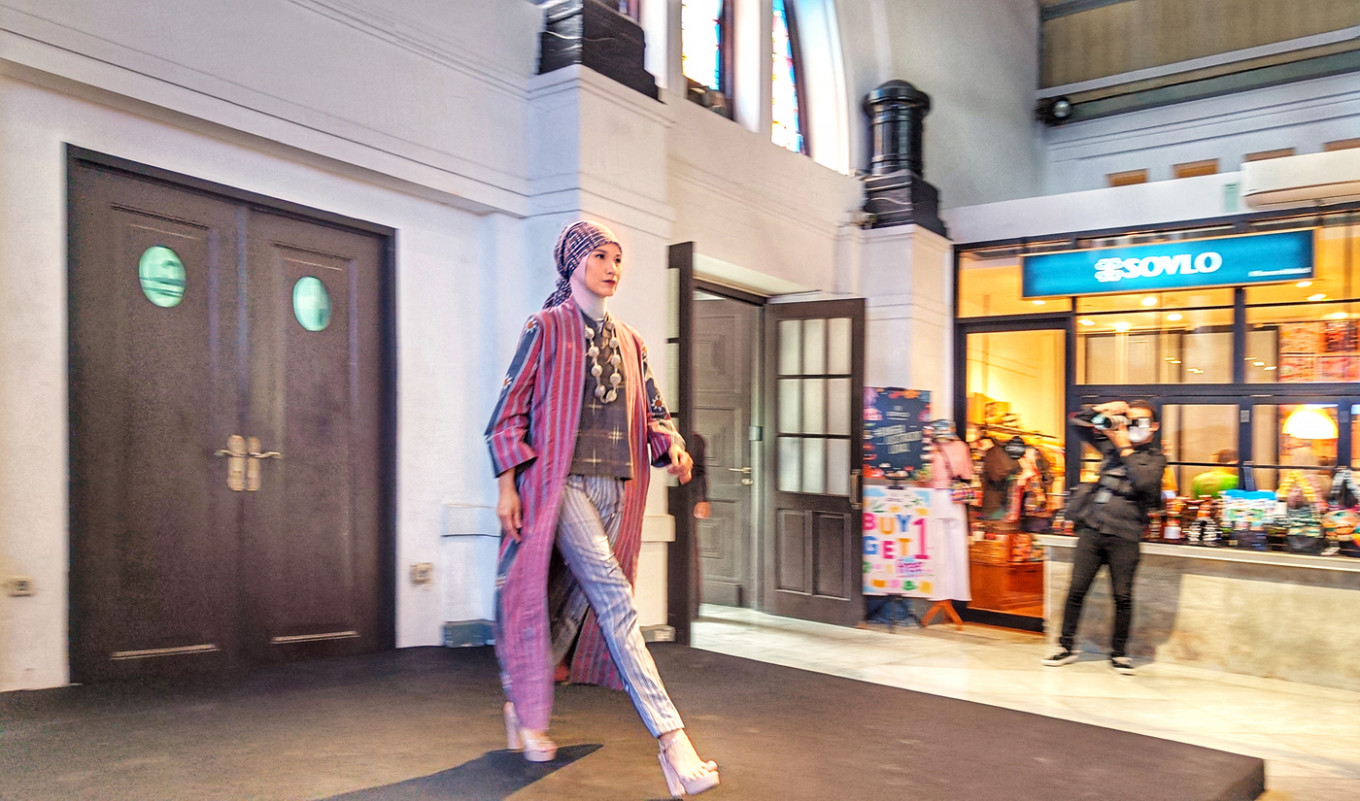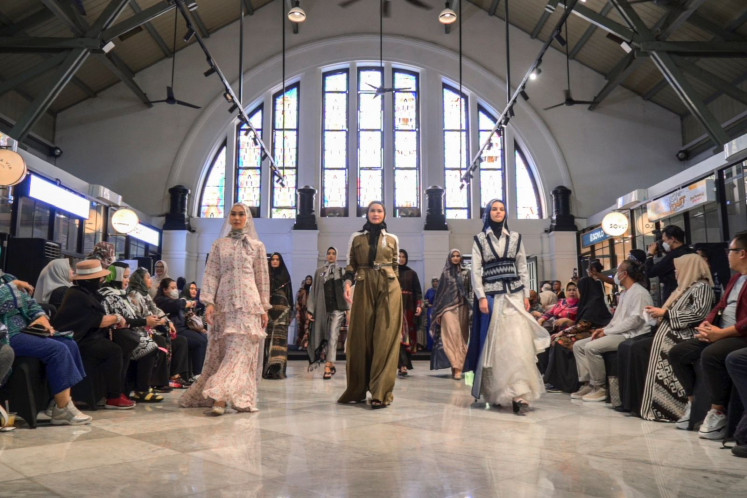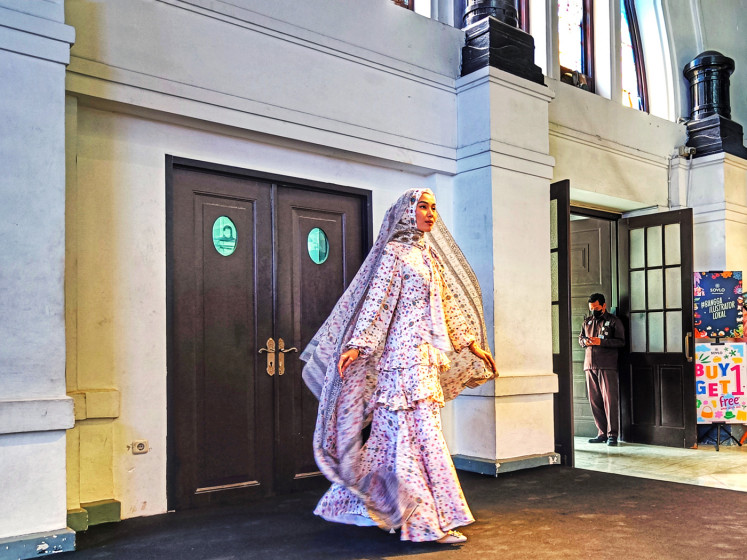Popular Reads
Top Results
Can't find what you're looking for?
View all search resultsPopular Reads
Top Results
Can't find what you're looking for?
View all search resultsIndonesia gears up to be the qibla of Muslim fashion in 2024
Change text size
Gift Premium Articles
to Anyone
Ministries, designers and other fashion stakeholders join forces to establish Indonesia as the center of Muslim clothing.
As the pandemic subsides, a series of Muslim fashion events kickstart in Indonesia. On Oct. 5 to 9, the IN2MOTIONFEST (Indonesia International Modest Fashion Festival) is held in the Jakarta Convention Center. The event, which is a collaboration between the Cooperatives and Small and Medium Enterprises (SMEs) Ministry, Bank Indonesia (BI) and the non-profit organization for Indonesian fashion designers, the Indonesian Fashion Chamber (IFC), will present 1,256 looks by 163 Muslim fashion designers in the country.
On Oct. 20-22, the Trade Ministry will also present Jakarta Muslim Fashion Week (JMFW) at the Indonesia Convention Exhibition (ICE) BSD City in Tangerang, Banten, featuring the latest collections by approximately 120 Indonesian fashion labels.
And early next year, the Muslim Fashion Festival (Muffest), the annual modest-wear festival by the IFC, will take place. In between, dozens of other modest fashion events will also be held in the country.
All these events portray Indonesia’s ambition to be the qibla of the world’s Muslim fashion in 2024.
The big plan
“The plan to establish Indonesia as the qibla of the world’s Muslim fashion was born in 2012 during the first Indonesia Fashion Week [IFW],” Ali Charisma, national chairman of the IFC, told The Jakarta Post on Sept. 19.
The IFC then formulated a blueprint, which consisted of measures to establish Indonesia as the center of Muslim fashion globally.
“However, we, as an organization, realized that we couldn’t do it by ourselves. Therefore, we’ve also engaged the help of the government, as well as other stakeholders,” Ali continued.
The Tourism and Creative Economy Ministry, Trade Ministry, Industry Ministry and the Cooperatives and SMEs Ministry then joined hands and signed a memorandum of understanding (MoU) to realize the plan by 2020.
But things did not quite go smoothly.
“As the ministers changed, their teams also changed and their ways of digesting the MoU also changed,” Ali continued. “So, every time [a minister changes], we start from zero.”
And with the pandemic hitting the world in 2020, the plan has then been pushed back to 2024.
Modest design: Pictured is some of the fashion collections presented at the IN2MOTIONFEST preview event in Pos Bloc, Jakarta, on Sept 29. (Courtesy of IFC) (Courtesy of IFC/Courtesy of IFC)‘It’s about time’
The trade minister seems quite enthusiastic to establish Indonesia as the center of the world’s Muslim fashion by 2024.
“It’s about time,” Trade Minister Zulkifli Hasan said during a press conference in the auditorium of the Trade Ministry on Aug. 23. “Indonesia has the largest Muslim population in the world and highly creative fashion designers, as well.”
According to the ministry’s data, Indonesia’s exports of Muslim fashion reached USD$2.85 billion in the first half of 2022, which was a 39.86 percent increase from the same period last year.
The number might seem quite big, but Indonesia is globally ranked number 13 on the list of the biggest Muslim fashion exporters, with a market share of only 1.86 percent.
“We’re way below Dubai, Vietnam and Bangladesh, which doesn’t really make sense,” the minister said.
On the other hand, Indonesia is currently the biggest consumer of Muslim fashion in Southeast Asia.
“And globally, we’re ranked as the number five among the biggest markets for Muslim fashion,” Fixy, partnership and market expansion assistant deputy at the Cooperatives and SMEs Ministry, said in the press conference in Pos Bloc, Jakarta, on Sept. 29.
“If we’re the biggest market for Muslim fashion, shouldn’t we lead [the market] and become the trendsetter for the world’s Muslim fashion?”
Fixy believes that IN2MOTIONFEST will help Indonesia achieve that goal.
“With the festival, Indonesia will bring the country’s modest fashion to the world, while towing the whole [Muslim fashion] ecosystem behind it,” Fixy added.
Building awareness
The IFC has also invited buyers from Europe, the Middle East and the United States to IN2MOTIONFEST and sent press releases about the event to major international publications.
“We hope the event will be a reference for Muslim fashion enthusiasts globally,” Ali said.
Indonesian fashion designers do not sit around waiting for international media and buyers to recognize their talents.
On Sept. 3 to 4, the IFC organized 16 Indonesian fashion designers to showcase their collections on the cruise ship Bateau Le Chansonnier and convention hall La Galerie Bourbon in Paris, in an event titled Front Row Paris.
“There were a lot of buyers from Paris and many other countries from around the world in the event,” fashion designer Nina Nugroho said on Sept. 19. “They all showed a great interest in our collections.”
During the event in Paris, Nina Nugroho presented a modest wear collection made of royal batik from Cirebon, West Java.
Although the event did not result in direct sales, Nina remained optimistic.
“The most important thing for us now is to build awareness [among international buyers],” Nina said. “[International buyers] should see that Indonesia is rich with handmade fabrics and that we, Indonesian fashion designers, are capable of creating them into great collections.”
Ali added that the Front Row Paris event was intended to give Indonesian fashion designers “a taste” of the international fashion market.
“We’re currently exploring the possibility of Indonesian fashion designers presenting their collections at Tranoï and Who’s Next,” Ali said, referring to two of the leading fashion trade shows in Paris.
“We hope that by next year, there will be one, two or three Indonesian fashion designers showcasing their collections in these trade shows.”
Ali continued: “Participating in Tranoï or Who’s Next would guarantee the designer’s business sustainability internationally. But in order to qualify, Indonesian fashion designers should be ready to mass produce and be consistent with their products' quality.”
Road to be the center of Muslim fashion: A model walks on the catwalk during the preview event at Pos Bloc, Jakarta. Ministries, designers and other fashion stakeholders prepare Indonesia as the qibla of Muslim fashion in 2024.(JP/Sylviana Hamdani) (JP/Sylviana Hamdani)Tough competitions
Indonesia will be facing fierce competitors in becoming the world’s Muslim fashion qibla.
“Turkey’s currently our head-to-head competitor,” Ali said. “Turkey has quite a similar profile to ours. The country is both a producer and large consumer of Muslim fashion.”
China, backed by its strong garment and textile sector, is also a tough competitor to Indonesia’s Muslim fashion industry.
“But no country can match the wealth of our handmade fabrics and products,” Ali said. “And that’s our main strength.”
Unfortunately, that strength is also a weakness. Local artisans usually take quite a long time to create a piece of batik and tenun (handwoven fabrics), which will also affect the fashion designers’ timetable.
During a discussion with the trade minister, Muslim fashion designer Ria Miranda revealed her experience in ordering fabrics directly from traditional artisans.
“Since the very beginning, my label has been consistent in featuring Minang [West Sumatra] heritage,” Ria said. “At first, I tried ordering my fabrics directly from local artisans in West Sumatra. But they had a hard time understanding the designs and took a very long time to make them. In the end, I decided to just use prints.”
Finding the right fabrics is also a problem.
“[There are] more and more Muslim fashion brands [emerging] each day, and yet the [amount and types of] fabrics remain the same,” fashion designer Ivan Gunawan said.
For his upscale Muslim fashion brand Mandjha Hijab, Ivan has to import quality silks from China.
“But this is also a problem,” Ivan added. “It often takes a long time to clear [the imported fabrics] from the customs. And this also hampers my production.”
Coordination
It seems that Indonesia has a lot of homework to do before establishing the country as the qibla for Muslim fashion in two years’ time.
“But I think it’s totally okay to sound the plan [of establishing Indonesia as the global center of Muslim fashion] now, while we’re still improving the industry internally,” Dina Midiani, member of the IFC advisory board and trend expert, said.
Currently, many stakeholders in the country’s Muslim fashion industry are moving forward to achieve the goal.
While the Cooperatives and SMEs Ministry and BI present IN2MOTIONFEST, the Trade Ministry is currently creating a database of Indonesian Muslim fashion designers, which will be published in an e-catalog for international buyers.
The Trade Ministry, in collaboration with Indonesia’s House of Representatives, is also working on Regional Comprehensive Economic Partnership (RCEP) agreements with South Korea and Dubai in order to exempt the country’s fashion products from import duties.
“Through Dubai, we can access the African market,” Trade Minister Zulkifli said. “There are over 1 billion people living in Africa. And they have similar [fashion] tastes to ours.”
However, a coordinated, concentrated effort is needed to establish Indonesia as the world’s Muslim fashion center.
“Currently, everyone makes their own paths,” Dina said. “The efforts are not yet integrated. It takes willingness from every stakeholder to set aside their own interests and sit together to formulate a coordinated action plan to achieve the target,”
“Without [coordination], we’ll just go round and round in circles.”













